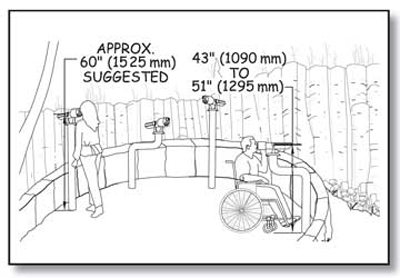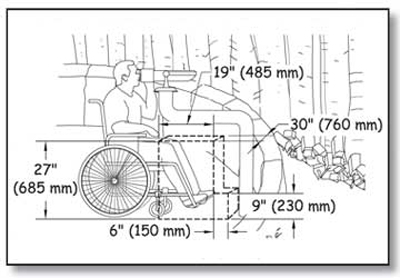Telescopes and Periscopes
Viewing areas are sometimes equipped with mounted telescopes or periscopes to provide the visitor with a better view of a point of interest. Whenever a telescope or periscope is provided, ensure that a separate telescope or periscope is available for use from a standing position (60 inches above the floor or ground surface is suggested) and from a seated position at each distinct viewing location. This allows all visitors to experience views similarly. Telescopes and periscopes that are usable from a seated position will provide the widest range of viewing opportunities for seated individuals, as well as children and people of short stature. The telescopes or periscopes at each location can be mounted separately or on the same pedestal. Telescopes or periscopes for use from a seated position must be connected to the other major constructed features at the recreation area by an outdoor recreation access route and meet the following requirements.
Ensure that controls and operating mechanisms for telescopes and periscopes usable from a seated position comply with the technical requirements for reach ranges and operability specified in ABAAS, sections 308 and 309, as explained in "Reach Ranges and Operability Requirements” of this guidebook. The eyepiece of each telescope or periscope usable from a seated position must be 43 inches (1,090 millimeters) minimum and 51 inches (1,295 millimeters) maximum above the floor or ground surface. Although not required, an adjustable scope mount is ideal for accessible viewing. Figure 97 shows one way to configure an accessible telescope area.

Figure 97—Requirements for viewing areas with telescopes and periscopes.
Provide a clear floor or ground space that is adjacent to (and may overlap) an outdoor recreation access route at all accessible telescopes and periscopes so that someone using a wheelchair or other assistive device can approach and move around them. This maneuvering space must be at least 36 inches by 48 inches (915 millimeters by 1,220 millimeters). Position the clear floor or ground space for a forward approach to the telescope or periscope and so that the eyepiece of the telescope or periscope is centered on the space. Provide knee and toe clearance complying with ABAAS, section 306, under the telescope or periscope (figure 98). Knee space under the telescope or periscope must be at least 30 inches (760 millimeters) wide, 19 inches (485 millimeters) deep, and 27 inches (685 millimeters) high, as measured from the ground or floor to the bottom of the structure that supports the telescope or periscope. Toe clearance of at least 9 inches (230 millimeters) above the ground or floor must extend at least an additional 6 inches (150 millimeters) beyond the required knee clearance.

Figure 98—Requirements for knee and toe space at telescopes and periscopes.

User Comments/Questions
Add Comment/Question